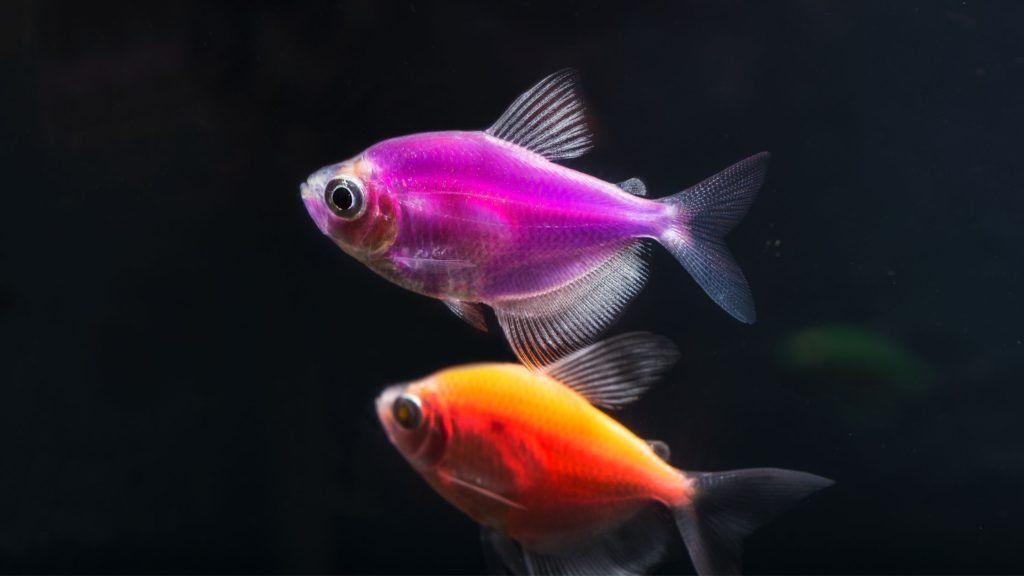Have you ever found yourself marveling at the sight of a beautiful, glowing fish weaving through the darkness of your aquarium like a tiny, living lantern? If you have, you’ve encountered the remarkable phenomenon of bioluminescence. This article focuses on one question many fish enthusiasts ask themselves – “Do glowlight tetras glow in the dark?”
Glowlight tetras are a widespread species in the aquarist community due to their vibrant coloration and unique glow. Understanding why and how these beautiful creatures light up the dark can provide fascinating insights into the natural world and aid you in creating an optimal environment for your aquatic pets.
Bioluminescence in Glowlight Tetras
Bioluminescence is a phenomenon in which organisms produce and emit light. The term originates from Greek – ‘bios’ meaning life and ‘lumen’ meaning light. This luminescence in organisms is often the result of chemical reactions or the presence of luminescent bacteria. So, does this process occur in glowlight tetras and make them glow in the dark?
Glowlight tetras, in reality, do not possess the ability to produce bioluminescence. Their distinctive “glow” is not derived from internal light production but from an optical phenomenon known as iridescence. Considering their name, this may come as a surprise, but their glow’s true origin is no less fascinating.
Iridescence: The Science Behind Glowlight Tetra's Glow
Iridescence is a form of structural coloration where the color we perceive doesn’t come from pigmentation but rather from the microscopic structure of the surface. In the case of glowlight tetras, the structural arrangement of their scales combined with light reflection and refraction gives them their characteristic glow. That means that, in essence, glowlight tetras do not glow in the dark. Instead, their iridescence shines brightly under appropriate light, giving an impression of bioluminescence.
The band of light seen in these tetras is due to guanine crystals within their cells. These reflective crystals give off a silvery, glowing hue when light shines. That is why you often see the glowlight tetras “light up” under aquarium lighting.
Does Glowlight Tetras Need Light to Glow?
Now that we’ve learned that glowlight tetras’ glow is due to the reflection and refraction of light rather than bioluminescence, it is clear that they need some source of light to exhibit their characteristic shine. Therefore, they do not glow naturally in the dark without any light source.
However, these lovely creatures are still active and exciting at night. Which leads us to the question – what is the glowlight tetras’ night behavior like?
Glowlight Tetras' Night Behavior
Aquarists often wonder how their underwater friends behave when the lights go out. Observing your glowlight tetras at night can provide exciting insights into their habits and adaptations.
Though not naturally bioluminescent, glowlight tetras become active when the lights go off. Their instincts drive their behavior during the night. In the wild, they originate from areas with dim light conditions, such as shadowed streams and tributaries. As a result, they have evolved to be quite active in lower light settings.
At night, glowlight tetras exhibit shoaling behavior – grouping and moving as one for protection and foraging. In the quiet of the night, you might observe them exploring their surroundings, searching for food, or interacting with other members of their shoal.
How to Enhance Glowlight Tetra's Glow
The “glow” of glowlight tetras is a feature many aquarists seek to enhance. While they do not emit light, their luminosity can be amplified with the right tank conditions and care.
Lighting: An appropriately lit aquarium can enhance the reflective glow of your glowlight tetras. A dimly lit tank can mimic their natural habitat, making the colors of your tetras pop and their “glow” more visible.
Diet: A well-balanced, nutritious diet can improve the overall health of your glowlight tetras, contributing to their vibrant coloration. Foods rich in carotenoids can significantly help intensify their colors.
Environment: Providing a tank environment that mimics their natural habitat can also enhance their glow. Dark substrates and plenty of plants can create a comfortable environment for these fish, which can, in turn, bring out the best of their colors.
Understanding Glowlight Tetra Luminescence: Do They Shine in the Dark?
To address the central question of this article – “Do glowlight tetras glow in the dark?” – the answer, as we’ve discovered, is no. Their luminescence is not self-produced, requiring an external light source to shine. However, with the proper care, environment, and lighting, their luminosity can be enhanced, creating a mesmerizing display of glowing colors that can add life and beauty to any aquarium.
The Impact of Environment on Glowlight Tetra's Glow
One cannot overstate the importance of the environment in influencing the behavior and appearance of glowlight tetras. Factors such as water quality, lighting, temperature, and decor can significantly affect their health and the intensity of their glow.
For example, maintaining clean water with the proper pH and temperature is crucial for their well-being. An environment that closely mimics their natural habitat – complete with plenty of hiding spots in the form of aquatic plants and dark substrates – can also contribute to their comfort and, in turn, their glow.
Having a school of glowlight tetras can make them feel more secure and less stressed, positively impacting their coloration. A stressed or solitary tetra is likely to lose its vibrancy.
Thus, the environment plays a crucial role in their behavior and well-being, enhancing their iridescence.
Do Glowlight Tetras Glow Naturally?
Given all we’ve learned about glowlight tetras and their stunning display, it’s clear their glow is not natural in the sense of being self-generated. Unlike certain marine species that can produce bioluminescence through chemical reactions within their bodies, glowlight tetras shine thanks to the interaction of light with the guanine crystals in their cells.
However, one might argue that their glow is natural in another sense – it’s a product of their biology, unique cellular structure, and environmental adaptation. The stunning, light-reflecting colors they exhibit are their own, not artificially induced or enhanced unless their owners make particular efforts with lighting and care.
The Science Behind Glowlight Tetra's Glow
The secret behind the glow of the glowlight tetra lies in their skin cells. Specifically, they have special cells called iridocytes or chromatophores that contain guanine crystals. These cells reflect light, creating the iridescent colors that make them appear to glow.
Guanine crystals are found in various animals and are responsible for many of the shiny and metallic appearances we see in nature, from the silver sheen of fish scales to the iridescent colors of butterfly wings.
When light hits the guanine crystals in the tetras’ cells, it is reflected in different directions. The diffused light appears as the colors that make up the glowlight tetra’s impressive display.
This scientific understanding allows us to appreciate the beauty of these creatures even more, recognizing that their glow is not just a pretty show but a remarkable biological feature.
FAQ: More About Glowlight Tetras and Their Glow
Do glowlight tetras glow without light?
No, glowlight tetras do not shine without light. They require an external light source for their colors to be visible.
Are there any risks to glowlight tetras associated with their glow?
There are no inherent risks to glowlight tetras related to their radiance. However, maintaining appropriate tank conditions and care is essential for their health.
Can the glow of glowlight tetras fade over time?
Yes, the shine can disappear if the fish becomes sick or stressed or the environmental conditions in the tank are unsuitable.
Can the glow of glowlight tetras be enhanced with unique lights?
Yes, certain types of aquarium lighting can enhance the perceived glow of these fish. However, care should be taken to avoid overly bright lights, which can cause stress to the fish.
Can other factors influence the glow of glowlight tetras?
Factors like diet, water quality, and overall health can affect the vibrancy of their colors.
Conclusion
Understanding the glowlight tetra’s ability to glow in the dark is a fascinating exploration of their biology and natural behavior. While they do not technically shine independently, their iridescent cells create a captivating display of colors that can appear as a “glow” under the right lighting conditions.
Remember, while their glow can be quite a spectacle, it’s important to prioritize their overall well-being and health. A well-cared-for glowlight tetra in a well-maintained tank environment will always show off its best colors.
As we unravel the science and intricacies of our pet fishes’ behaviors and characteristics, we only grow to appreciate them more. The glowlight tetra is a testament to the beauty and wonder of aquatic life. And that, even without true bioluminescence, can illuminate our understanding and love for these delightful marine creatures.
Related Articles

Mastering the Art of Dog Training: How to Train Your Dog to Stop Barking
Introduction to Dog Barking

How to Clean Goldendoodle Ears: Preventing Infections
Welcome to our essential

Top Picks: Best Harness for Goldendoodle Revealed!
Welcome to our comprehensive

Insider Tips for the Perfect Goldendoodle Diet
Struggling with your Goldendoodle’s

Goldendoodles Grooming: The Ultimate Toolkit for Perfect Care
Table of Contents Welcome

Discover the Perfect Dog Nail Grinder for Your Furry Friend
Finding the ideal dog nail

